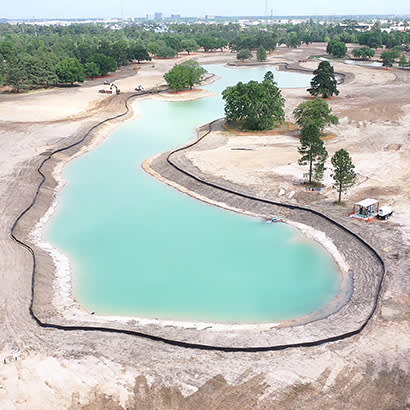
The city of Houston’s Memorial Park Golf Course is undergoing an $18 million facelift to transform the municipal course into a state-of-the-art facility and future home of the PGA Tournament’s Houston Open. While the catalyst for this change is a desire to return the tournament to Memorial Park, the new design will produce a model for creating sustainable golf courses across the country.
Giles Kibbe, president of Astros Golf Foundation — the charity hosting the tournament — explains why Houston Astros owner Jim Crane and his team entered into a public-private partnership to renovate the course. “Houstonians have always talked about trying to move the Houston Open back to Memorial Park. To make that happen, there needed to be a significant upgrade in the facilities, but the money wasn’t there to make it happen. When we agreed to run the tournament, we felt like Jim and the Astros had a voice that could get the community behind this project and raise the funds to finally make it happen.”
Finding the Right Designer
Considerations of the historic nature of the course, the Memorial Park Master Plan and PGA Tournament needs drove the Astros Golf Foundation to select Tom Doak, a golf-course architect who has designed multiple top-rated courses around the world, to design the new course.
When asked how Doak was selected, Kibbe explains, “There are only a handful of golf course architects who have designed multiple courses that are ranked in the top 100 in the country. We interviewed all of them — Tom being one. We brought four of them to look at Memorial Park. They were all very interested in working on our project, but we felt like Tom was the best fit. He has a great vision for the redesign and has a tremendous desire to turn Memorial Park into one of the best courses on the PGA Tour. The one thing that Tom has not done in his career is design a course that hosts a PGA Tour event. He wanted to do that, and the PGA Tour was excited about having him do it.”
With Doak on board, the redesign of the course was set to not only put Houston back in the center of the golf world, but also to create a model for golf course sustainability through stormwater management.
Sustainable Water Management
Kibbe continues, “The plan included getting the golf course irrigation system off the city’s potable water. The course was using 60 million gallons of potable water each year to irrigate the golf course. As a critical part of our course redesign, we had Tom design a stormwater retention and irrigation system that would capture the vast majority of stormwater at the course and store it to be reused to irrigate the course.”
Don Mahaffey, president of Greenspace Methods, is on the ground overseeing the renovation process. He explains, “The retention pond will have 3 feet of watertight freeboard. This will allow for water storage in all parts of the pond.”
Mahaffey also explains that the project will not only expand the amount of rainwater that can be stored, but will also expand the network of pumps covering the northern side of the golf course that feed stormwater into the lake.
Houston Parks and Recreation Department Golf Course superintendent Jason Harsh is excited about the changes and the course designer. He says, “Tom wanted this challenge to design a course that would challenge the PGA Tour players, while also providing a challenging and fun course to play for the amateurs.”
Harsh goes on to say, “The department’s overall goal is to build a sustainable golf course and reduce water usage by 50 percent — a goal projected to be met within three years thanks to the renovation. The new retention system will allow water runoff from 65–70 acres of the course to be reused for irrigation. That, along with individual sprinkler control, new computer application technology to start and stop the system and the use of soil moisture meters to identify water needs of specific turf areas make the system a win-win for the city and Memorial Park Golf Course.”
The new system allows for the fine tuning of each sprinkler to use only the water it needs in any given area. This is a big improvement over programming the 14,000 sprinklers in three-head blocks and risking over- or under-watering parts of the course. To further maximize water efficiency, drought-tolerant turf and vegetation will also be installed on the course. These improvements also take into account environmental factors unique to Houston by incorporating the course’s topography into the water management design.
Kibbe explains, “Based on Houston’s annual rainfall, this new network of small ravines and expanded lakes will capture 80 million gallons of stormwater that can be reused to irrigate the golf course. Depending on when that rainfall occurs, we might not need to use any city water in the future. This will save the city a lot of money, conserve water and reduce discharge into Buffalo Bayou. We are providing a tremendous benefit to all of Houston for years to come.”
The Astros, coming off their 2017 World Series victory, are helping to open a new era in Houston sports by spearheading the renovation of Memorial Park Golf Course. The upgraded course, opening late 2019, will put Houston on the national stage once more and provide a model for sustainable municipal golf courses across the country.
Kibbe hopes that moving the Houston Open to the newly renovated Memorial Park will “transform the Houston Open into one of the premier events on the PGA Tour” and “help [Houston] promote the city during a nationally televised event.”
Steve Wright is the Director of Houston Parks and Recreation Department (@HPARD).


